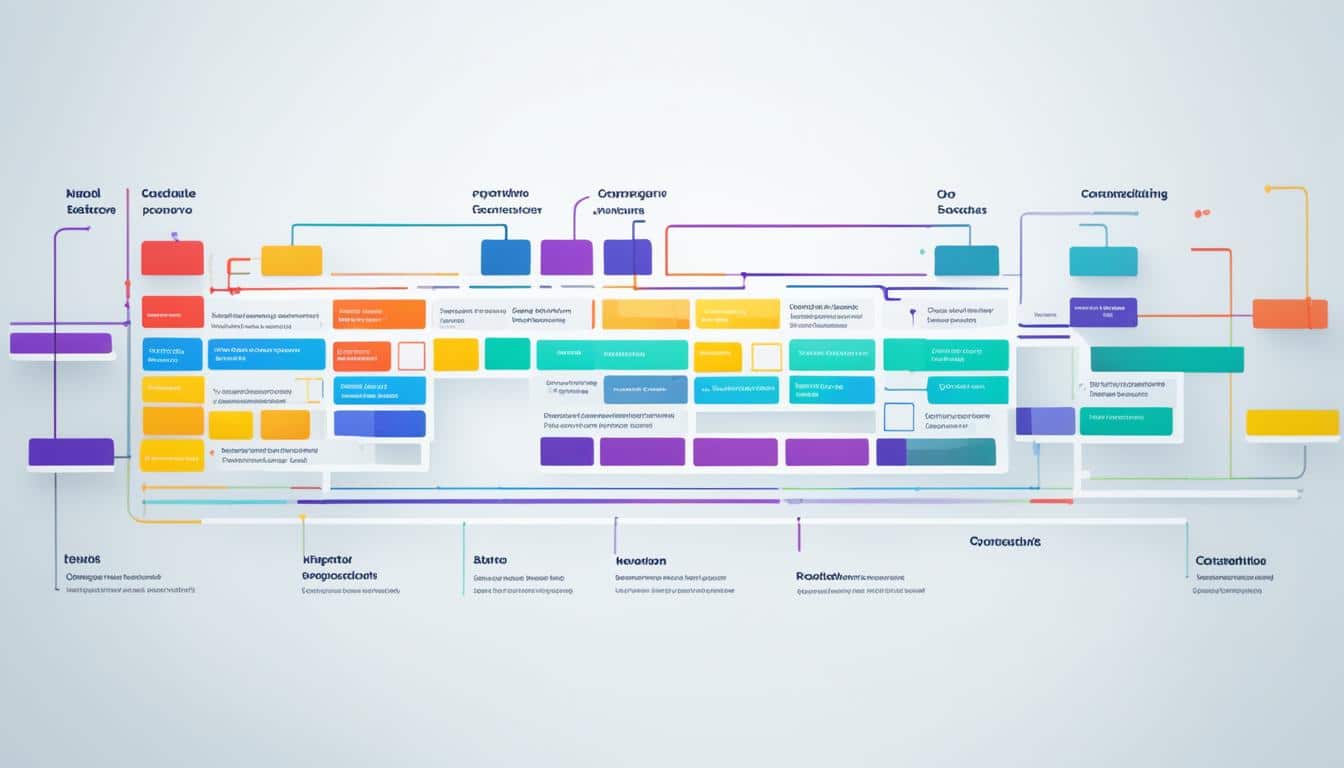Menu

Did you know Netflix grabbed an impressive 85% of the digital video market? Their smart use of digital tools helped. This changed entertainment for good. Looking at how Netflix and Amazon used digital tools helps others in the tech world stay competitive.
This article looks at how companies use digital tools. With examples from big names, it shows how digital can boost customer interest, make work smoother, and help businesses grow. By studying these cases, you’ll see the real wins of using digital tools.
Today’s business world moves quickly. It’s essential to use the latest tech solutions. Digital tool implementation means putting these innovations into how a business works. It’s a key step in making sure digital changes are positive.
Using digital tools means adding new tech and software to business tasks. For instance, people might use Amazon’s cloud services or analytics tools like AB InBev’s BEES platform. These tools show the big changes and benefits businesses can see.
It’s very important for companies to become digitally advanced. Amazon’s move into B2B was worth a lot, showing digital growth’s huge benefits. Netflix shows how leading digitally can win big market shares. This puts digital tools and a smart strategy in the spotlight.
Digital tools offer lots of pros. They improve how a business runs and the experience customers have. Tesla, for example, saw a huge jump in car sales after using more digital tools. Under Armour used tech buys to make interacting with customers personal.
| Company | Investment | Notable Achievement | Impact |
|---|---|---|---|
| Amazon | Cloud Services | B2B Wholesale Market Integration | Captured market valued between $7.2 – $8.2 trillion |
| Netflix | Streaming Technologies | 85% Market Share | Surpassed other streaming giants |
| Tesla | Connected Car Technology | Vehicle Delivery | 87% Increase in Deliveries |
| Under Armour | Fitness Organisations | Acquired for $715 million | Enhanced Digital Business Stream |
Using digital tools well can hugely change businesses for the better. It boosts efficiency, makes customers happy, and helps companies grow. Looking at different success stories, it’s clear: being digitally advanced is not just a trend, it’s key for success.
Amazon Business is a shining example of how a company can grow from B2C to B2B. It shows how a strong presence in the digital world can lead to new successes. This move has not only reached new customers but also kept showing Amazon’s leadership in using technology to get ahead.
Amazon is at the forefront of the digital revolution. By taking on new technologies, it has transformed how it works. For example, Amazon is a big player in eReaders, selling 60% of these devices worldwide in 2017.
Amazon’s approach to digital transformation is broad. It includes using the latest technology, improving how customers interact with them, and making their operations better. For instance, their AutoGluon service helps developers make advanced apps with AI on Amazon Web Services (AWS).
Amazon’s digital moves have had a big impact. Their smart supply chain uses automation and robots to bring customers fast and cheap delivery. Other businesses can take notes from Amazon to be more efficient and cost-effective too.
Amazon also carefully integrates data and operations. This makes sure they offer customers exactly what they want all in one place.
Looking at how Amazon and Alibaba use technology, we see some differences:
| Aspect | Amazon | Alibaba |
|---|---|---|
| Customer Experience | Highly personalised | Efficient and transparent |
| Technological Integration | AI, Machine Learning, AWS | eCommerce technologies |
| Operational Efficiency | Robotics, Automation | Streamlined processes |
These in-depth digital strategies not only make Amazon stronger but also give good examples of using technology well.
Netflix’s journey from a DVD rental company to a global streaming giant is a clear example of technology’s power. By offering on-demand services, Netflix reshaped the way we view entertainment. Through smart tech investments and a strong content base, it attracted countless subscribers. Let’s dive into the details of Netflix’s success story.
Moving to online streaming in 2007 led to huge success for Netflix. It saved them from high postage costs and bad brand reputation. Nowadays, Netflix is valued at nearly $145 billion, showing its massive impact. The pandemic boosted its subscriber numbers by 36 million.

Netflix spent $15 billion on new content to keep viewers hooked. It used smart algorithms to make personalised suggestions, keeping users engaged. Going global helped Netflix offer a mix of content that appeals to everyone.
Despite a drop in subscriber growth due to a 2019 price increase, Netflix bounced back. Its revenue kept growing, and its stock price surged by 6,230% over ten years. Even with price hikes, Netflix remains a dominant force, with 20% of the North American market in 2010.
| Aspect | Details |
|---|---|
| Valuation | Almost $145 billion in 21 years |
| Stock Rise | Skyrocketed by 6,230% in a decade |
| Content Investment | $15 billion commitment |
| Subscriber Increase | 36 million during the COVID-19 pandemic |
| Market Share | 20% in North American viewing traffic by 2010 |
Elon Musk’s vision has pushed Tesla to the front of car tech. They use digital tools to make cars better and keep customers happy. Tesla’s connected car tech is a great example of how digital tools can work well.
Tesla has changed how we see car maintenance by leading in connected car tech. This means cars can always get better without needing to come in. This keeps cars safe and working well. Tesla shows us how well advanced tech can fit into cars today.
Tesla stands out in updating cars over the air (OTA). They can send updates from afar to make cars work better, fix issues, and add new things. For example:
Tesla does things differently. Their OTA updates keep making cars better. This makes customers happier and more loyal. Plus, these updates help use less energy, fitting their goal for a greener future.
| Metric | Details |
|---|---|
| Net Worth (2021) | $158.5 billion |
| Global Workforce Growth (2019-2020) | 47%, adding over 70,757 employees |
| Offices | 12 offices across 9 countries |
| Global Sales Reach | 30 countries with retail presence in 9 foreign markets |
| Pre-orders for Cybertruck | 200,000 within the first month |
| Annual Revenue (2019) | $20 billion |
| Market Capitalisation (Jan 2020) | $107 billion, surpassing Volkswagen |
This shows how Tesla’s connected car tech is leading in innovation. Their story in using digital tools well sets them apart in the car world.
Glassdoor changed how we hire by using digital tools to make hiring clear and easy. The Glassdoor case study proves that work reviews and ratings really impact how employers are seen. Job seekers find reviews helpful. And employers learn what they need to do better from these.

Glassdoor uses digital tools to help over 3,000 companies with hiring and branding. They have also given out 55,000 free accounts to employers. Many companies in Fortune’s “Best Places to Work” list did very well, showing how important a good image is.
Glassdoor is part of a bigger trend of making work more open online. Amazon Business is growing in a $7.2 to $8.2 trillion market, and Netflix dominates digital video. This shows how powerful being digital and open can be.
By using digital tools, Glassdoor shows how technology can really help businesses grow. This means companies that use tech well, like Tesla with its cars, are ready for the future job market.
| Company | Initiative | Impact |
|---|---|---|
| Glassdoor | Recruitment Tools | Enhanced Transparency and Market Outperformance |
| Amazon Business | B2B Marketplace | Tapping into a $7.2-$8.2 Trillion Market |
| Netflix | Digital Streaming | 85% Market Share in Digital Content |
| Tesla | Connected Car Technology | Improved Customer Experience and Emission Reductions |
The Glassdoor case study shows how important using digital tools in hiring is. It’s a good example for other businesses. Using technology well makes a business more efficient and competitive in today’s fast-changing world.
Under Armour is leading in merging technology with fitness and business. It has bought top tech fitness companies. This has strengthened its Connected Fitness plan, aimed at bettering customer experiences [source].
Under Armour invested $715 million to buy MapMyFitness, MyFitnessPal, and Endomondo apps. This big buy helped create a powerful fitness world. With these, Under Armour got ahead in the tech fitness game [source].
Their heavyweight is in using tech to collect health data from 180 million users. They manage this data with cutting-edge Amazon services. This setup helps create custom fitness plans for users around the globe.
Under Armour’s apps send lots of data through Apache Kafka, making quick insights. They mix this tech with user info to offer special products. This combo of physical and digital worlds supports each user’s fitness goals.
With over 35 years in the HVAC business, Faulkner Hayes saw how manual work had inefficiencies. They needed digital tools to improve how they worked and served customers better.
Manual work in HVAC often means delays and inaccuracies. Faulkner Hayes found that handling orders took too long. They also saw problems in keeping track of inventory and accessing live data easily. All these made serving their customers fast and staying ahead tough.
They knew they had to change. So, Faulkner Hayes brought in digital tools to boost how they worked. An ERP system was a big step. It joined all their work together. Now, they could keep an eye on stock live, process orders without much work, and get everyone working in sync.

Digital tools really changed things for the better. Customer questions got answered much quicker. Automating simple tasks meant their team could spend more time helping customers with bigger things. This made Faulkner Hayes both more efficient and better at making their customers happy.
The Faulkner Hayes case study proves how much digital tools can do. They can make work smoother and customers happier. By following digital tools implementation case studies, other companies can also do better at their job.
LEGO has been moving towards digital ways wisely. They’ve changed how they work and made their position in the market stronger. They are big on using new technology and quick methods. This has really helped them change.
LEGO started by fixing its big computer system to share data better. They started making and showing things online when they were in big trouble in 2004. Stepping into the digital world stopped them from going bankrupt again.
Following flexible ways has really changed how LEGO works. Most of their teams now work in a fast and smart way. For example, the finance team finished a big job much sooner than they thought they could.
The LEGO case studies show they prefer clever solutions over perfect ones. This has made them face changing market needs better.
LEGO has improved its website a lot with projects like LEGO Ideas. This has helped them learn what people really like. They use ideas from the public to make things better suited to their customers.
They’ve also upgraded how they share their brands with other companies. This move has made LEGO a creative and digital-friendly company. It’s not just about toys anymore.
| Aspect | Impact |
|---|---|
| Agile Adoption | 65% of teams fully/partially embraced agile methodologies, transforming structure to be product-oriented |
| Supply Chain Planning | Quick adaptation with “good enough” tool, early market benefits |
| Finance Department Project | Achieved MVP in 800 hours over 8,000 estimated hours |
| Digital Crowd-Sourcing Via LEGO Ideas | Better alignment with market trends, enhanced consumer engagement |
Espinoza’s Leather Company started a noteworthy change by going mostly paperless. They found that using more digital technology greatly improved their business. It showed how important it is to update old ways and become more efficient with new tools.
The company used to do everything by hand. But, now they process orders digitally. They can now handle orders, track them in real time, and manage stock more easily. This has cut down on mistakes and made sending out orders much quicker.
Switching to digital has brought many benefits. For example, communicating with customers takes 50% less time. It’s also easier to find and keep records without all the paper. Plus, not using as much paper saves the company money on printing and storage.

The change to digital has had a big impact at Espinoza’s Leather Company. They’ve seen better sales and can manage their work more effectively. With digital tools, they can now handle more orders smoothly. This has made them a stronger player in the market. Also, their customer service has improved, which is vital for business success.
| Statistic | Value | Impact |
|---|---|---|
| Reduction in Customer Communication Time | 50% | Streamlined Processes |
| Cost Savings on Paper | Significant | Reduced Overheads |
| Order Handling Efficiency | Improved | Enhanced Speed and Accuracy |
This case study from Espinoza’s Leather Company shows how digital changes bring big benefits. It’s not just about working better. It’s also about growing the business and making customers happier.
AB InBev uses cloud data to make its business act smarter and make better choices. By bringing together data from over 50 countries and hundreds of brands, they manage their supply chain better. This makes everything work together well.
AB InBev brought all its data from various breweries into one place as part of its digital change. This included half a year of facts from a New Jersey site, looking at more than 50 aspects. The big data collection helped make predictions better and improved how things are done. For example, it cut down the time it took to solve customer issues from 20-25 days to just 7, a huge change.
AB InBev uses BEES, its online selling place, in smarter ways because of behavioural analytics. By studying how people act and buy, the company made credit rules tighter. This led to less money owed and more focused ads. And guess what? Sales and happy customers both went up.
Working with Google Cloud partners, AB InBev got better at using filters. This helped run more barrels through each time by 60%. Using Pluto7’s AI tech also sped up making beer and kept the quality high. These steps made customers even happier, fitting with their high-tech manufacturing vision.
Ford is embracing digital innovation in the car world. This change is big for the company. It meets what today’s buyers want and protects our planet. Ford is putting less into older ads like TV and more into online adverts. They are using places like Facebook, Instagram, and Twitter to reach more people. Now, they can show off their brand and green projects to a bigger crowd.
Ford makes its ads personal using data. This means they speak directly to what each person likes. It helps sell more and makes customers stay loyal. Ford is also big on going green. They push for electric and hybrid cars, following the world’s lead on helping the planet. Their digital moves show how much they care about the environment and their customers.

Keeping customers happy is key for Ford. They use engaging marketing methods like interactive events and test drives. This makes people really connect with the brand. Ford also works hard to talk to all sorts of customers. Everyone feels like the brand speaks to them.
Customer feedback is crucial for Ford. They listen and use what people say to better their digital work. This keeps their technology and products up to date. They make sure to always be what customers need in today’s fast-paced car market.
In the end, Ford’s move towards more digital stuff is about looking ahead. It’s not just about selling cars, but making sure people love what they get. It’s also about being a leader in caring for the planet in the car business. Ford is all about the new and the good, from how they manage their car business to keeping customers happy and being eco-friendly.
By studying many examples, we’ve seen common positive impacts on business. These studies highlight the value of using digital tools effectively.
Different industries show us how digital change can succeed. Amazon Business, in the B2B market, is worth noting. It tailored its services to meet business needs, adding significant value. Netflix stands out too, capturing a large share of the digital video market. Its focused use of technology has boosted its success greatly.
Tesla is another example, with a significant increase in car deliveries in 2021. This success was largely due to innovative digital technology. It’s clear that using digital tools can lead to big market benefits and better customer service.
Implementing digital changes can be tough. Companies often need to break old habits and learn new skills. Overcoming these issues needs careful planning. A solid strategy, shared with everyone, can align the team towards success.
| Challenge | Solution |
|---|---|
| Unlearning old habits | Providing continuous training and development programmes |
| Technological adoption | Investing in user-friendly technologies and robust IT support |
| Cultural resistance | Encouraging an open dialogue and creating a culture of innovation |
Companies that focus on their customers, stay agile, and engage their employees do well. Take Under Armour’s investment in digital fitness – a smart move towards transformation. And Glassdoor using data to surpass market expectations, proves the value of data.
Digital transformation is never done. Ford’s consistent updates to its FordPass app keep it ahead. This ongoing improvement is vital for staying competitive.
Lastly, knowing what you want to achieve is crucial before starting any digital change. It’s about both enhancing customer experience and improving business operations. This balanced approach is key to digital success.
It’s key for businesses to have a strong digital strategy to keep ahead in the digital world. Linking digital goals with your main business objectives helps make things easier and makes customers happier. Here are some tips to help you on your digital journey:
Start by looking at your business’s aims and goals. Knowing what you want and where you currently stand is critical. It helps build your digital plan. For instance, Amazon Business hit a huge B2B market in the U.S. by matching its goals with what the market needs. By focusing on your own business goals, you can use digital tools more effectively.
Choosing the right technologies is a big part of your digital plan. Look at Under Armour. They got ahead by buying key companies. This cost them $715 million. Remember, pick technologies that not only work now but also in the future.

Digital change is not just a one-time deal. It’s an ongoing process. Updating all the time lets businesses keep getting better. Look at how Tesla boosted car deliveries by 87% with updates. This kept them ahead in the market.
| Company | Transformation Strategy | Results |
|---|---|---|
| Amazon Business | Targeted B2B market | Access to $7.2-$8.2 trillion market |
| Netflix | Advanced streaming technologies | 85% market share |
| Tesla | Connected car technology | 87% increase in deliveries |
| Glassdoor | Digital recruitment tools | Outperformed S&P 500 by 84.2% |
| Under Armour | Acquisition of fitness tech companies | $715 million investment |
| Baystone Media | Adopted Whatfix DAP | Enhanced product adoption |
Following these guidelines and always improving can lead your business to digital success and excellence.
In looking at many case studies, it’s clear that using technology well makes a big difference in businesses. Companies all over the world are getting great results from using digital tools. A big 52% found their workers did more, and 49% said they were doing better overall. This shows how helpful technology can be.
Take Domino’s Pizza as an example. By embracing digital tools, its stock price went from $5.95 to an amazing $396.96. Now, over 70% of its sales come from online orders. They’ve also cut delivery times to less than 30 minutes. Plus, making ads more personal helped sales go up by 3.9% in 2020.
Walmart, Netflix, and Nike are other great examples. Walmart used £11 billion to improve its stores with new tech and data handling. This made it easier to make decisions and get better results. Netflix is now worth £149 billion because of its strong use of digital tools. And Nike’s focus on online shops doubled its sales in Japan. They aim for half their sales to be online by the end of the year.
These cases really show how technology can change a business for the better. They not only make customers happier—44% noticed this—but also help keep success going. As we move into a more digital world, these stories can guide others on the path to success through digital change.
They are real-life stories about how companies bring new tech into their work. This helps businesses to grow and serve their customers better. These stories show what they did and the good results that followed.
It’s key for companies to stay ahead, improve how they work, and offer better services. Going digital helps them do new things and find more ways to succeed. It makes their operations smarter, quicker, and ready for growth.
By going digital, companies can become more efficient and connect better with customers. This can lead to making more money and smarter decisions. They can also become faster at adapting to changes around them.
Amazon Business made buying and selling easier on a special site. They offered many products, custom delivery choices, and direct talks between makers and buyers. These changes made shopping more personal and led to big new sales.
Netflix changed how people watch shows and movies by moving from DVDs to streaming. Their clever use of tech, like suggesting what to watch, meant more people signed up. This made Netflix a top choice, especially when many stayed home during the pandemic.
Tesla’s cars can fix problems from afar, needing fewer trips to the shop. This makes driving safer and more fun. It also helps to cut down on pollution, which is good for the planet.
Glassdoor shows what it’s really like to work at different places through reviews. This helps job hunters pick better jobs and companies choose their staff more wisely. It has become a top tool in the job world.
Under Armour used tech from companies that focus on fitness to better serve their customers. This led to custom fitness plans, making a complete digital fitness brand. It puts customers first in their health goals.
Faulkner Hayes found manual work slow in their heating and cooling jobs. Switching to automatic systems made them faster and better at helping their customers. This move put them at the top of their field.
LEGO made all their tech systems work together better, creating a stronger online presence. This let them connect more with people who love their toys, leading to lasting success. Their digital change brought fans closer.
Espinoza’s Leather found they spent less time sorting out orders and sold more by going digital. They also had a better handle on how their business was running. This shift improved many areas of their business.
AB InBev gathered all their brewery info in one place digitally, making managing and deciding things faster. They also studied how people shop online to make their marketing better and friendlier to consumers. This tech change made lots of things smoother for them.
Ford brought in many new digital services to look after cars better. They focused on making car use better for customers and leading a big change in the car industry. These digital steps have brought Ford’s service up to a new level.
Companies sometimes find it hard to change the way they work and to use new tech. To get past these challenges, careful planning, ongoing training, and making sure everyone is on the same page with digital goals is essential.
It’s crucial for companies to focus on their customers, be flexible in their business designs, and keep their staff involved in the changes. They should always look for ways to do things better for their customers and their business.
Companies should first figure out what they want to achieve and then pick the tech that will help them get there. It’s all about getting started, learning from mistakes, and getting better, always aiming to match their digital plans with their main goals.